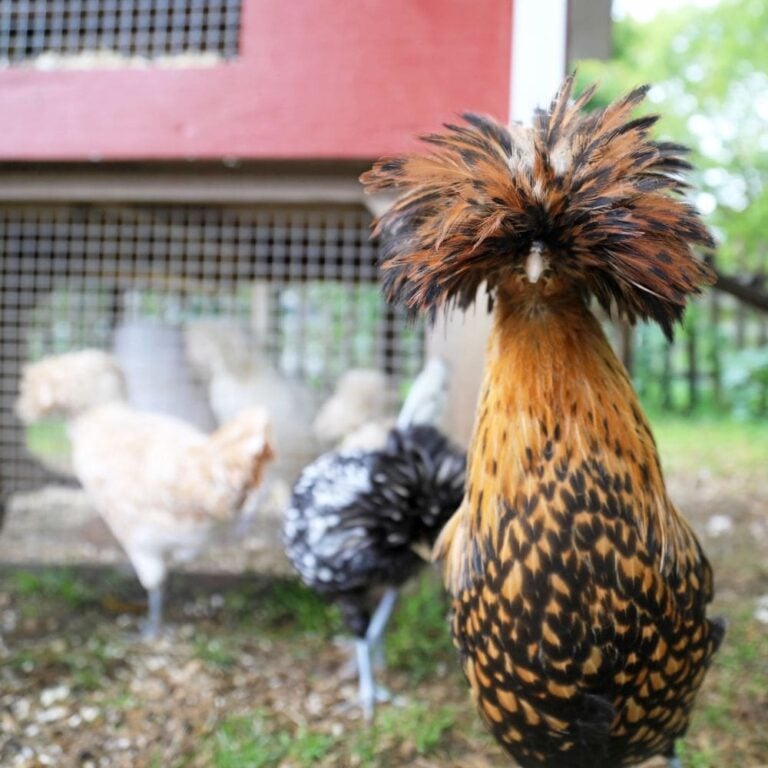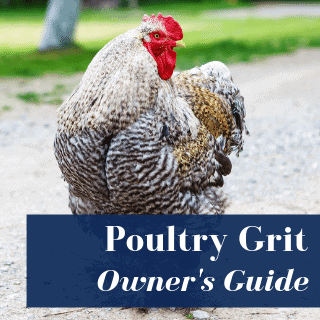Building a chicken coop – or at least providing a safe home – is a task we take on the moment we bring home chickens for the first time.
With a such a huge task like this, it’s easy to get overwhelmed – especially after you realize that your new feathered friends are a meal for hungry predators.
In this article, I’ll take you step by step and answer all your “how to build a chicken coop” questions.
Whether you’re using small or large chicken coop plans, or if you’re adventurous enough to tackle a walk in chicken coop, we’ll give you enough details so crafting your chicken house is easy peasy.
Table of Contents (Quickly Jump To Information)
Build A Chicken Coop & Keep Out Predators In 11 Easy Steps
- Choose chicken coop plans that allow at least 10 square feet of space per chicken. It’s okay to alter them for your needs.
- Your ideal coop should also be at least 8 feet tall so you can easily clean the coop
- Add roosts at least 6 feet off the ground so your chickens are protected at night
- Before building, decide on a location – it should be partly shaded if you live in a warm climate.
- You can use recycled materials or new.
- Screws make it easier to correct mistakes, and are stronger than nails. Use an electric screwdriver or nail gun to speed up building a coop.
- Add an automatic coop door so your chickens are safe at night
- To keep them safe from predators, the run should be at least 8 feet high, and made of hardware cloth or chicken wire.
- Secure chicken wire with industrial staples or screws and washers.
- Add chicken wire underground to prevent predators that dig.
- Add 1 nesting box for every 3 chickens (more on this below)
How Much Does It Cost To Build A Chicken Coop?
Chickens are incredibly low maintenance. You can build a coop for free using reclaimed materials, or spend $5000 and up (especially if you’re using chicken coop plans for 12 chickens), depending on the size, features, materials, and furnishing.
It goes without saying that building a DIY coop would likely be more cost-effective, especially when using recycled materials.
You’ll need to buy:
- Wood
- Nails or screws
- A hammer (or nailing gun, which is what we use)
- Roofing materials (using corrugated tin makes it easy and creates a nice finished product, but you can also use wood and shingles)
- Flooring, depending on whether you’ll have a floor in your coop or not.
- Circular saw for cutting wood
- Chicken wire or hardware cloth for windows and the run
Of course, you have to assess your strengths and capabilities in handling power tools too. You wouldn’t want to lose a finger, right?
Pallets are also a free way to build a chicken coop (just make sure they’re safe to use). You can get these from local businesses (just be sure to ask whether you can take them).
You can find a lot of inspiration about how to build a chicken coop out of pallets with my free plan ideas here.
Do Chickens Need a Coop?
While the idea of having chickens roam around your backyard day in, day out is what dreams are made of, you’re not the only one watching your hens.
Chicken predators are a big issue when it comes to taking care of our flocks.
Quite at the bottom of the food chain, our fluffy butts are hunted by animals morning to night, both from the air and land, and from the water if there’s an alligator swamp nearby.
Aside from that, chickens also need a place to stay in during the cold winter months and during inclement weather. Nothing is more dangerous to your flock’s health than the cold and damp!
You can find different free chicken coop blueprints and plans with hen houses for flocks as small as 2 and even specific chicken coop plans for 6 chickens online – so there’s really no excuse to not build a chicken coop for your feathered friends.
You can find 55 free small and large chicken coop plans here.
How Much Room Do Chickens Need In A Coop?
The rule of thumb is 10 square feet of space per chicken, although more is better. This is true whether you’re wondering “how big should a coop be for 20 chickens?” Particularly since chickens will poop everywhere, and soon you’ll have a mucky mess in your run. The more space they have, the less they’ll scratch their area to dirt.
Exercise is important for chickens and it’s not really in their DNA to stay indoors and knit. It’s part of their personal care to spend time and figure out how to peck a worm from the ground!
Do Chickens Need To Free Range?
This is a common question, and can help you decide how big to build a chicken coop for your backyard. While chickens would love to free range and get supplements to their diet from mother nature herself, there are a few issues with safety (i.e. foxes and coyotes). Also, your hens might decide to hide their eggs if they’re allowed to free range for long periods.
Plenty of chickens are happy living in their coop and run full time, and so you should build a coop and run that’s large enough to safely house your flock full time.
Do Free Range Chickens Need A Coop?
Free range chickens need a run for training, management, and bad weather (and even shade in hot weather). Even when free-ranged, you still want your chicken to roost and lay in one place. Ideally, that would be a chicken coop with a run – and learning how to build a chicken run is no different than building a coop.
How To Build A Chicken Coop Out Of Pallets?
You’ll find that tackling chicken coop plans for 50 chickens can be scary to the pockets.
But not if you find the right materials! Pallet wood can be recycled into a cute coop, especially since they’re made from lumber that’s designed to be a sturdy transport structure.
Thinking of using these materials to build your chicken coop is not a crazy idea.
You can break the pallets down and start building the chicken coop based on the design that you chose. You can resize the pallet, or keep them the way they are for a rustic, shabby-chic look.
How Many Chickens Can I Fit In My Coop?
A frequent questions I get is “How many chickens can you put in a 4×8 coop?”
There are a lot of websites advertising that 4ft x 8ft coops can house 15-20 chickens. This isn’t really true. Your chickens should have about 10 square feet of space per hen. So, a 4×8 coop with be comfortable enough for 3 normal size birds (araucanas or speckled sussex chickens) and 4-5 bantam silkie hens. It wouldn’t be large enough for larger breeds like brahma chickens, though.
Just remember that these are general guidelines – what YOUR coop needs depends on the individual personalities of your fluffy butts. However, as a general rule, chickens like space, and the more, the better. Like every other animal, they have different personalities so personal space is important.
Bantams require less space compared to heavy breeds. Try to take the size of the breed into consideration when wondering “How big should a coop be for 20 chickens?” or more.
Here’s some other common questions:
What size of coop do I need for 10 chickens? – Ideally 100 square feet.
How much room do you need for 12 chickens? – 120 square feet is best.
What size coop do you need for 6 chickens? – 60 square feet so they have enough space.
What size coop do I need for 8 chickens? – 80 square feet is ideal.
How Tall Should My Chicken Coop Be?
Realistically, you’ll need to clean your chicken house– right? So, it’s best if you can easily get in and out of a walk in chicken coop. In other words, your coop should be tall enough that you can walk inside. Additionally, you’ll want your chickens safe from predators, right? The taller the better – your chickens will roost at dusk, and they’re less likely to become a meal for a predator if they’re 5-6 feet in the air.
What Should Be Inside A Chicken Coop?
At a minimum, you’ll want chicken feeders and waters, nesting boxes, and roosting bars. Adding bedding such as shavings, hay, or straw on the floor helps provide a clean living area. You can also include toys, a droppings board (to make manure clean up easier), and even a roll away nest for easier egg collection.
You can get a full list here.
How Many Nesting Boxes Does A Hen Need?
When building your coop, a good general rule is 1 nesting box per 3 hens. However, you’ll find that your hens will all likely lay in the same box, and they might even fight over them!
How Many Nesting Boxes Do I Need For 20 Chickens?
Based on experiences in the farm, 6 boxes would be enough for 20 chickens. They might only use two of those and making one nesting box for each hen is overkill.
You can find out more about nesting boxes in our article here.
How Do You Clean A Chicken Coop?
Want to do it right? I have a full article here (and all-natural coop spray recipes here and a coop refresher recipe here). Here’s some additional tips!
- Use a garden hoe for roosting bars – chicken poop all the time when sleeping. Run the hoe over the bars and you’ve got a clean slate!
- The hoe magic also works for nesting boxes. Pull out whatever material you used as a bedding with the hoe. Replace with bedding and don’t forget your nesting herbs!
- A rake, stall pick, and a shovel will come in handy for the floor. Dried poop can be as tough as concrete so be prepared with your muscles. You can use a hose to soften it up too!
- Vinegar can be a friendly cleaning agent. After scraping everything, slosh pure or diluted vinegar and brush. Rinse and air dry!
- DO NOT use chlorine or bleach – it will mix with the ammonia in your flock’s urine. You’ll then create a very dangerous gas! It’s best to stick with all natural solutions for cleaning your coop.
As stated before, you should build a chicken coop tall enough so you can easily clean it.
How Long Can You Leave Chickens In Coop?
It’s safest to leave them in a coop with enough food and water for no more than 24-48 hours in temperatures less than 70 degrees F. Over 80 degrees F, it’s not safe to leave them locked in a coop at all because they might get heat stroke or suffocate.
Chickens have a mind of their own and are quite self sufficient. However, we’ve taught them to rely on us for food and water. And the longer they’re locked up, the more likely they’ll develop bad habits and respiratory issues from urine and dust.
If you’re planning a vacation, it’s best to call a chicken sitter to look after your feathered babies!
How Do I Keep My Chickens Warm In The Winter?
If you plan to build a chicken coop, you’ll want to make sure it’s warm enough during freezing temperatures. There are some effortless steps with big-time effects that you can do to keep your chickens warm during winter months.
- Close the gaps – make sure that there are not drafts to minimize wind chill. Check gaps every year especially when the coop has been their shelter for more than 5 years.
- Petroleum jelly against frostbite – wattles and combs are susceptible to frostbite. A great way to prevent this from happening is using grandma’s answer to all your problems – PETROLEUM JELLY. Cover these areas and they’ll be safe.
- Let them cuddle – Chickens roost together. They share and generate heat this way. Giving them enough space to roost together would keep them warm. Also make sure that it is at least a feet above the ground to prevent contact with the cold ground.
- Deep litter works! – This isn’t just about not cleaning the litter. Deep litter bedding is a well managed process that if done right would add to the heat the chickens need. What you have to do is to sprinkle tree shavings like pine or other organic matter over the floor. Use a rake to stir it. Regularly top up with shavings. Once the litter forms a compost layer, it will help insulate the coop. Also, the compost has good microbes that eat the bad bacteria from the litter.
Hopefully this article has given you lots of ideas to build a chicken coop and keep out predators (without getting completely overwhelmed by the process). Have a question? Leave a comment below!
Maat van Uitert is a backyard chicken and sustainable living expert. She is also the author of Chickens: Naturally Raising A Sustainable Flock, which was a best seller in it’s Amazon category. Maat has been featured on NBC, CBS, AOL Finance, Community Chickens, the Huffington Post, Chickens magazine, Backyard Poultry, and Countryside Magazine. She lives on her farm in Southeast Missouri with her husband, two children, and about a million chickens and ducks. You can follow Maat on Facebook here and Instagram here.







Thank you for your informative articles!
We’ve just a a bunch of our chickens killed during the midmorning here in eastern Pennsylvania (between 1st and 2nd collection).
The bodies were piled neatly in the corner of the coup. Only one was opened in the belly. The rest seemed to have head/neck injuries, but were not eaten. Any thoughts on what I’m dealing with in eastern PA?
Thank you, again!
It’s so hard to say. Could a dog have access to the coop? Most predators will eat the chickens (or just kill one and eat it), but leaving them in a pile sounds like a dog.